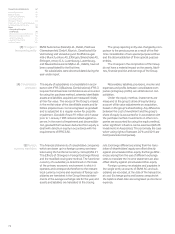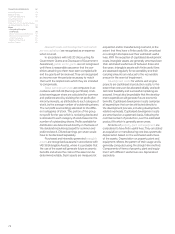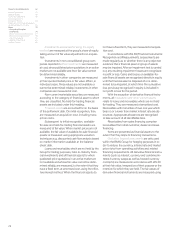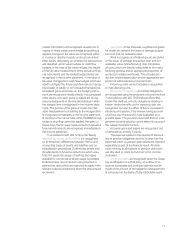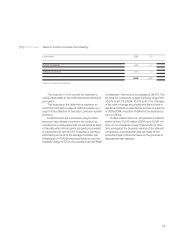BMW 2005 Annual Report Download - page 81
Download and view the complete annual report
Please find page 81 of the 2005 BMW annual report below. You can navigate through the pages in the report by either clicking on the pages listed below, or by using the keyword search tool below to find specific information within the annual report.80
current items depending on their remaining term or
their relationship to the normal operating cycle of an
entity. In conjunction with the new classification of
the balance sheet by maturity, certain balance sheet
items have been sub-classified into their constituent
parts and presented accordingly. The presentation
changes made in connection with the new balance
sheet classification rules do not have any impact on
profit or loss.
The main changes were as follows:
Receivables from sales financing, financial as-
sets and other assets are classified on the basis of
the current/non-current distinction.
Prepayments are reclassified to other assets.
Other provisions, financial liabilities and other
liabilities are classified on the basis of the current/
non-current distinction. In addition, a number of
items previously reported in provisions have been
reclassified to liabilities in accordance with interna-
tional practice.
Deferred income is reclassified to other liabilities.
Deferred tax assets and liabilities are not classi-
fied as current in accordance with applicable rules.
(b) Amendment to IAS 19 (Employee Benefits:
Actuarial Gains and Losses, Group Plans and
Disclosure)
In December 2004, the IASB issued a revised ver-
sion of IAS 19, permitting actuarial gains and losses
arising in conjunction with defined benefit pension
obligations to be recognised directly in equity. The
amount of actuarial gains and losses recognised
directly in equity is shown on page 69.
Under the corridor method previously used by
the BMW Group, actuarial gains and losses were
recognised when their net cumulative amount
exceeded the higher of 10% of the present value
of the obligations or 10% of the fair value of plan
assets at the end of the preceding period. The
amount exceeding the corridor was required
to be recognised as income or expense over the
average
remaining working lives of the employees
participating in the plans concerned. Fluctuations
in the net cumulative amount of actuarial gains and
losses within the corridor were not recognised on
the grounds of immateriality. Unrecognised actuarial
losses represented a short-fall in the amount recog-
nised as liabilities in the balance sheet.
In accordance with the new accounting option
for pension obligations, the full amount of previously
unrecognised actuarial gains and losses is required
to be recognised directly in equity. The revised rules
do not envisage recognition through profit or loss
of the amount by which actuarial gains and losses
exceed the 10% corridor.
In order to improve transparency in its financial
reporting, the BMW Group has elected to apply the
option made available by the IASB to change the
accounting treatment for pension obligations and
has adopted the amendment early at 31 December
2005.
Necessary adjustments for the financial year
2004 as a result of retrospective application have an
impact on periodic result, equity, pension provisions
as well as deferred tax assets and liabilities.
The following components of the financial
statements are affected by the change in account-
ing policy for defined benefit pension obligations:
– Group and sub-group Income Statement
– Group and sub-group Balance Sheets
– Group and sub-group Cash Flow Statements
– Statement of Changes in Equity
– Segment Information
The restatement of the comparative figures for the
financial year 2004 gives rise to an improvement in
profit before tax of euro 29 million. After recognising
a deferred tax expense of euro 9 million, the net
profit for 2004 increased by euro 20 million to euro
2,242 million.
The adjustment to equity for periods prior to
2004 amounted to euro 751 million. Equity in the
balance sheet at 31 December 2004 decreased by
Group Financial Statements 62
Income Statements 63
Balance Sheets 64
Cash Flow Statements 66
Group Statement of
Changes in Equity 68
Statement of Income and Expenses
recognised directly in Equity 69
Notes 70
--Accounting Principles
and Policies 70
--Notes to the Income Statement 81
--Notes to the balance sheet 90
--Other Disclosures 114
--Segment Information 121
Auditors’ Report 125




